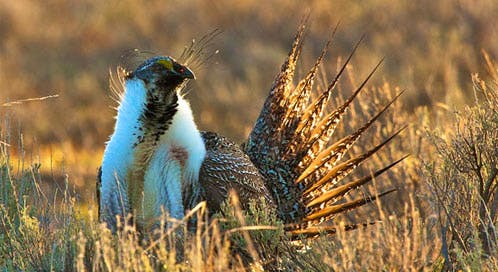Ranging over ten western states, greater sage-grouse have lost nearly half their original habitat, and their populations have experienced long-term declines. In 2010, the U.S. Fish and Wildlife Service determined the bird warranted protection under the Endangered Species Act – a decision that sparked concern among industries like oil and gas development and agriculture, which would prefer to use sage-grouse habitat for their own purposes. The Bureau of Land Management (BLM), and the U.S. Forest Service as a cooperating agency, set out to improve management plans to support sage-grouse recovery before the Fish and Wildlife Service makes its formal listing decision in 2015. This new planning strategy is intended to update nearly 100 federal land use and management plans with new conservation measures for sage-grouse on 60 million acres of public land. Needless to say, given the inherent conflicts of interest, we were concerned that the needs of sage-grouse might not be prioritized in the planning process.
Today, Defenders released “In the Red: How Proposed Conservation Plans Fail to Protect Greater Sage-Grouse.” This comprehensive report documents how draft plans released under the federal National Greater Sage-grouse Planning Strategy fail to adopt conservation measures required to conserve and restore sage-grouse and their habitat.
Greater sage-grouse are one of the best studied species in the West, and we poured over reams of published research and government and scientific reports to identify key strategies to conserve the grouse. We used these conservation measures to evaluate how well BLM’s draft plans would conserve and restore sage-grouse and their habitat.

The planning strategy partitions existing sage-grouse habitat up among 15 different management plans.
What we found wasn’t pretty: Many of the conservation measures in the draft plans are biologically or legally inadequate, and must be improved in final plans in order to provide for the long-term conservation of sage-grouse. The plans were also markedly inconsistent, proposing dramatically different conservation measures for sage-grouse range-wide and even between adjacent planning areas. While sage-grouse occur across large landscapes, the planning process was partitioned into 15 different areas, each with its own approach to protecting sage-grouse. Dividing the habitat along these imaginary lines may be helpful from a human perspective, but not really for sage-grouse.
One measure that the BLM utterly failed to implement is designating new reserves for sage-grouse protection. Though the agency analyzed approximately 44 million acres of priority sage-grouse habitat for special designation, they only proposed to designate about 50,000 acres as reserves. This would mean that less than one percent of sage-grouse habitat would be specially protected for the species.
The good news is that federal planners have another chance to adopt effective conservation measures for sage-grouse in the final plans. In fact, most of the draft plans analyzed our key conservation measures, but simply declined to include them in their proposed management schemes. This means that the BLM doesn’t have to start over with the planning process to issue strong final plans for sage-grouse.

The sage grouse has lost much of its habitat to agriculture, development and other factors.
Federal lands are key to sage-grouse conservation and recovery. Our report includes recommendations for BLM to ensure that public lands, which contain the majority of remaining sagebrush habitat, contribute to the conservation and restoration of the species. Our recommendations to federal planners include:
- Finalize the draft plans together in a centralized process that can more effectively address their many deficiencies and resolve their discrepancies so that the 15 final plans implement consistent, adequate, regulatory conservation measures to conserve and restore sage-grouse and their habitat.
- Conserve essential habitat to support sage-grouse conservation and restoration, and permanently protect the most important areas as sagebrush reserves to serve as strongholds for sage-grouse and other sagebrush-dependent species.
- Focus habitat restoration on areas most likely to improve habitat quality and connectivity to expand sage-grouse current range and reclaim parts of historic range for use by the species.
- Account for the effects of climate change on sagebrush habitat by anticipating future habitat and species shifts and supporting habitat resilience to climate change.
Although sage-grouse may be the best-known species in the Sagebrush Sea, they are not the only species of conservation concern : more than 350 other fish, wildlife and plants in sagebrush grasslands are also at risk. Greater sage-grouse are an “umbrella species” for the landscape – by adopting the conservation measures in our report, the BLM can protect sage-grouse and benefit a host of other species dependent on sagebrush habitat. This is a once-in-a-lifetime chance to implement transformative, lasting conservation measures for an entire imperiled ecosystem. Let’s hope we get it right.
Mark Salvo, Director of Federal Lands Conservation
Noah Matson, Vice President of Landscape Conservation & Climate Adaptation



